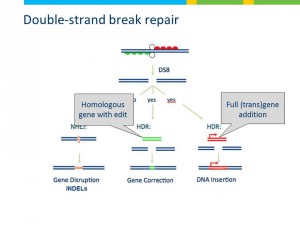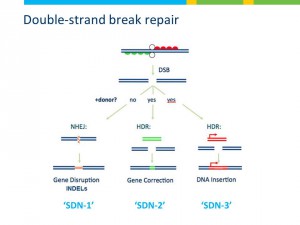Site-Directed Nuclease (SDN) genome editing involves the use of different DNA-cutting enzymes (nucleases) that are directed to cut the DNA at a predetermined location by a range of different DNA binding systems. After the cut is made, the cell’s own DNA repair mechanism recognizes the break and repairs the damage, using one of two pathways that are naturally present in cells:
- non-homologous end-joining (NHEJ): The cut DNA is rejoined, but while doing this a few basepairs may be eaten away or added resulting in random small deletions (up to 20) or additions (a few basepairs) of nucleotides at the cut site.
- homology-directed repair (HDR): a donor DNA that carries the desired change and has homology with the target site is used to introduce this change at the cut site. In this way you can introduce specific intentional insertions, changes or deletions.


Genome editing allows the intentional and precise knock out of an undesirable trait or the (re)introduction of a desired trait.
Nuclease mediated genome editing techniques include:
